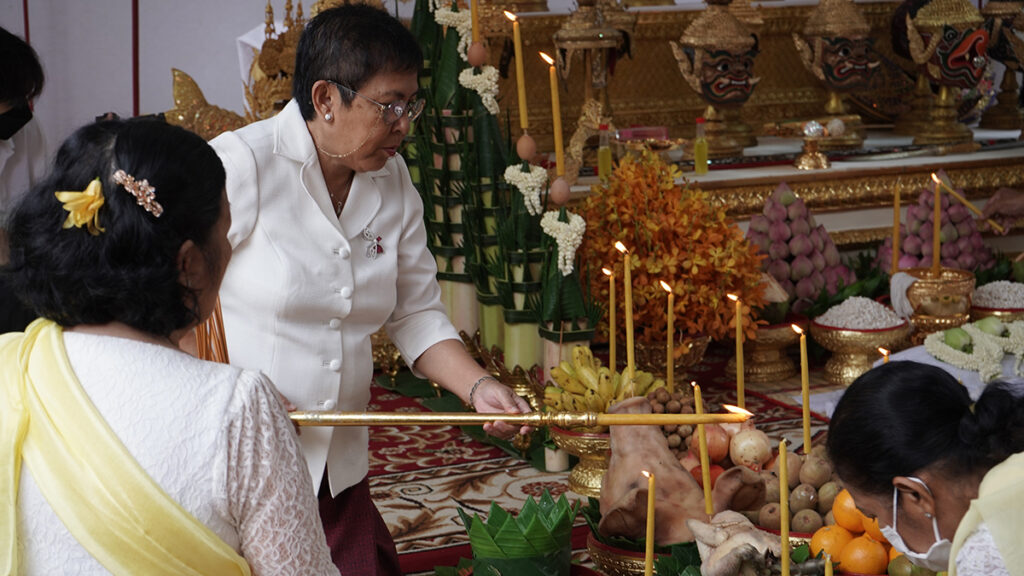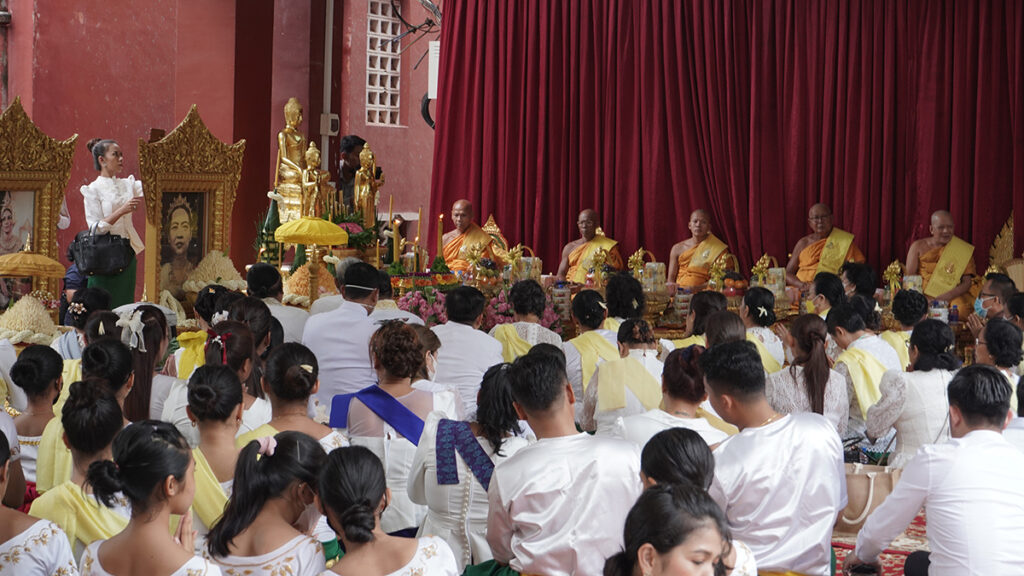នៅថ្ងៃទី១៤កើត ខែស្រាពណ៍ ព.ស. ២៥៦៦ ត្រូវនឹងថ្ងៃព្រហស្បតិ៍ ទី១១ ខែសីហា ឆ្នាំ២០២២ នៅសាកលវិទ្យាល័យភូមិន្ទវិចិត្រសិល្បៈ «ពិធីបួងសួងរំឭកវិញ្ញាណក្ខន្ធនិងវិញ្ញាណក្ខន្ធព្រះបរមគ្រូ» បានត្រូវរៀបចំនិងប្រារព្ធធ្វើឡើងដោយសិល្បករនិងសិល្បការិនីនៃក្រសួងវប្បធម៌និងវិចិត្រសិល្បៈ ក្រោមអធិបតីភាពដ៏ខ្ពង់ខ្ពស់សម្តេចរាជបុត្រីព្រះអនុជ នរោត្តម អរុណរស្មី និងលោកជំទាវបណ្ឌិតសភាចារ្យ ភឿង សកុណា រដ្ឋមន្ត្រីក្រសួងវប្បធម៌និងវិចិត្រសិល្បៈ។

នៅក្នុងឱកាសដ៏សក្ការៈនេះ គ្រូស្រីនិងអ្នករាំស្លៀកពាក់អាវប៉ាក់ពណ៌ស និងក្បិនពណ៌បៃតង ទៅតាមថ្ងៃប្រពៃណីពណ៌ថ្ងៃព្រហស្បតិ៍។
នៅផ្នែកម្ខាងនៃវេទិកាបុណ្យ មានព្រះសង្ឃ ៩អង្គ និងបារគូ បីនាក់ ហើយនៅម្ខាងទៀត មានម្កុដនិងមុខខ្មុកព្រមទាំងដង្វាយមានម្ហូបចំណី បង្អែម ផ្លែឈើ លាជ និងទឹកអប់ប្រេងម្សៅ ទៀនធូប ព្រមទាំងប្រទីបជ្វាលា រៀបចំជារណ្តាប់ថ្វាយ។ ឯអ្នកចូលរួមក្នុងពិធី អង្គុយបត់ជើងនៅកណ្តាលវេទិកាបុណ្យ។

ជាប្រពៃណី គេជ្រើសរើសយកថ្ងៃព្រហស្បតិ៍ដើម្បីប្រារព្ធពិធីនេះ ព្រោះថ្ងៃព្រហស្បតិ៍ជាថ្ងៃដែលមានថាមពលខ្លាំងជាងថ្ងៃឯទៀតៗនិងជា «ថ្ងៃគ្រូ» ផង។ នៅពេលមុននឹងពិធីចាប់ផ្តើម សិស្សរៀងៗខ្លួន ជូនទៀននិងធូបទៅគ្រូដែលបានបង្រៀនខ្លួន។
ពិធីសំពះគ្រូ ចែកជាបីដំណាក់៖ (១) ពិធីបួងសួងរំឭកគ្រូ (វប្បធម៌ ភ្លេង របាំ) (២) ពិធីសាសនា និង (៣) ពិធីបួងសួងរំឭកគ្រូ (វប្បធម៌ ភ្លេង របាំ)។
(១) ពិធីបួងសួងរំឭកគ្រូ (វប្បធម៌ ភ្លេង របាំ)
អ្នកចូលរួមទាំងអស់បែរមុខទៅរកអសនៈ ទីសក្ការៈតម្កល់ដង្វាយ ម្កុដ និងមុខខ្មុក។

១. អាចារ្យ ចាប់ផ្តើម (មើលក្រាំង) ឧទ្ទិសបួងសួង ប្រកាសសូមពរជ័យ សូត្ររំឭកឈ្មោះគ្រូទាំងអស់ដែលបានចែកឋានទៅ។ អាចារ្យ យាងនិងអញ្ជើញគ្រូ គ្រូស្រែក គ្រូច្រៀង គ្រូហ៊ោ សូមឱ្យមកចូលរួមក្នុងពិធី។ អាចារ្យថ្វាយភ្លេង ដោយហៅឈ្មោះភ្លេង និងបទភ្លេងពិណពាទ្យ៖
១. សាធុការ
២. ប្រោសព្រំគ្រូធំ
៣. ផ្លិ
៤. ហក់
៥. ដំណើរសត្វខ្លុម
៦. រោទ៍សាម៉ាឡា (រោទ៍ ៣ជាន់)
៧. ស្មើខណ្ឌសមុទ្រ
៨. ជើតឆាន
៩. សន្ធឹកក្នុង ៣ជាន់
១០. ខែកបរិច្ឆេទ (ខែកបរិឆេត)
១១. បឋម (ប្រធំ)
១២. ពោលខោលដោយអាចារ្យ – ទទួលដោយសិស្ស (ភ្លេងបទជើតចាប់)
១៣. សិស្សរាំថ្វាយដង្វាយ រាំបែរមុខទៅទិសទាំងបួន។
(២) ពិធីសាសនា
អ្នកចូលរួមទាំងអស់ បែរមុខទៅព្រះពុទ្ធរូបនិងព្រះសង្ឃ។
១៤. សាធុការ (គណៈធិបតីនិងគ្រូ អុជទៀនធូប បាញ់ទឹកអប់ទៅលើព្រះភ័ក្ត្រព្រះឆយាលក្ខណ៍)។ បារគូបីនាក់ សូត្រនៅមុខអសនៈនិងព្រះឆយាលក្ខណ៍ បួងសួងសូមពរជ័យ អញ្ជើញព្រលឹងគ្រូសូមឱ្យមកចូលរួមនិងដឹងឭ។ រួចហើយ បារគូផ្លុំស័ង្ខ បីដង។
១៥. សាធុការ
១៦. ព្រះសង្ឃ ៩អង្គ នមសិការ សូមព្រះវិញ្ញាណក្ខន្ធនៃគ្រូដែលបានចែកឋានទៅ សូមភ្ញាក់ស្មារតី។ ពុទ្ធសាសនិកចូលរួមក្នុងពិធី សូត្រ នមោទស្ស។ ព្រះសង្ឃ សូត្ររំឭកគ្រូ បែបបុរាណដែលមានភាពខុសប្លែកពីធម្មតាដែលធ្លាប់ឮ។ បន្ទាប់ពីព្រះសង្ឃនមសិការ អាចារ្យនាំសូត្របន្ត («អនុមោទនា»)។ ជាបន្ទាប់ គឺការវេរថ្វាយ ដោយអាចារ្យសូត្របន្ត (ស្មឹងស្មាធ ប្រមូលអារម្មណ៍ រួចថាតាមអាចារ្យ)។ អាចារ្យហៅឈ្មោះគ្រូ ប្រកាសថា «បានចាត់ចែងនាំមកហើយនូវចង្ហាន់បិណ្ឌបាត បានមកដោយធម៌ កើតឡើងដោយធម៌ ដែលមានព្រះពុទ្ធរូបស្នងព្រះអង្គជាប្រធាន»។ ពិធីបង្សកូលជាបន្ត អ្នកចូលរួមទាំងអស់ បែរមុខទៅព្រះឆយាលក្ខណ៍ សូត្រធម៌ ស្រោចទឹកថ្វាយនិងជូន ប្រោសព្រំដោយគ្រូ ហើយមានភ្លេងទទួលបន្តិច រួចចប់ពិធីសាសនា (ព្រះសង្ឃនិមន្តនិវត្តត្រឡប់ទៅវិញ)។

(៣) ពិធីបួងសួងរំឭកគ្រូ (វប្បធម៌ ភ្លេង របាំ)
អ្នកចូលរួមទាំងអស់បែរមុខទៅរកអសនៈ ទីសក្ការៈតម្កល់ដង្វាយ ម្កុដ និងមុខខ្មុក។នៅក្នុងពិធីស្រង់ទឹក អាចារ្យហៅភ្លេងបន្ត។
១៧. ភ្លេងស្រង់ទឹក (គ្រូបាញ់ទឹកអប់លើម្កុដនិងមុខខ្មុក)
១៨. ភ្លេងសែនព្រេន
១៩. ភ្លេងបាចលាជ (បាចលាជលើម្កុដនិងមុខខ្មុក)
២០. សិស្សរាំថ្វាយ ទៅតាមតួ៖ យក្ស ស្វា នាង និងនាយរោង (ភ្លេងខែកមន ២ជាន់ ឆា បញ្ចុះ)
២១. បទព្រះថោង (មានចម្រៀង) រាំរបាំព្រះថោង
២២. របាំបួងសួងព្រាហ្មណ៍
២៣. របាំបាចផ្កា
២៤. របាំអប្សរា (ដោយសិស្សមកពីប្រទេសបារាំង (Ballet Classique Khmer))
២៥. បង្វិលពពិល
២៦. ជើតជូនគ្រូ
(ចប់ពិធី)
ពិធីទាំងមូល មានរយៈពេលប្រមាណ ២ម៉ោងកន្លះ (ពីម៉ោង ៨:០០ ដល់ម៉ោង ១០:៣០)។ បន្ទាប់ពីពិធីសំពះគ្រូបានប្រារព្ធធ្វើសព្វគ្រប់ហើយ អ្នកចូលរួមនិងពុទ្ធសាសនិកក៏បានចូលរួមនៅក្នុងពិធីរាប់បាតជាបន្តរហូតដល់ចប់៕
——————————–
PITHI SAMPHEAH KROU ROBAIM KBACH BURAN KHMER OR CEREMONY OF PAYING HOMAGE TO THE TEACHER’S SPIRITS IN KHMER COURT DANCE
On Thursday, August 11, 2022 at the Royal University of Fine Arts, a ceremony of paying homage to the teacher’s spirits was initiated and organized by the artists of the Ministry of Culture and Fine Arts graciously presided over by Her Royal Highness Princess Norodom Arunrasmy and Her Excellency Dr. Pheourng Sackona, Minister of Culture and Fine Arts. On this sacred occasion, female teachers and dancers wore white embroidered blouses and green tucked at the waist skirts.
On one side, there were nine monks and three Brahmin priests—Barkous—and on the other side, there were crowns and paper-machet masks, as well as, offerings of foods, desserts, fruits, popped rice, perfume, oil, powder, candles, and incense-sticks along with illuminated lanterns arranged as offerings. Whereas the participants sat down on the floor in the middle of the sacred and ceremonial area.
They chose Thursday to celebrate this event because Thursday is believed to possess the highest energy of all the other days and is also known as the “Guru Day.” Before the commencement of the program, students presented candles and incense-sticks to their teachers who have personally taught them.
Pithi Sampeah Krou is divided into 3 parts: (1) Teachers’ imploration ceremony (culture, music, dance), (2) Religious ceremony, and (3) Teachers’ imploration ceremony (culture, music, dance).
(1) Teachers’ Imploration Ceremony (Culture, Music, Dance)
The officiator started by reading the prescribed manual, exclaiming prayers, dedication to, and proclamation of all the deceased teachers. The officiator, then, invited the teachers’ spirits to the ceremony. The officiator offered music by calling out the titles of the musical pieces of the Pinn Peat court ensemble. Toward the end of this part, students danced carrying trays of offerings turning to the four cardinal points.
(2) Religious Ceremony
Presided over by nine high-ranking Buddhist monks, three Brahmin priests—Barkous—chanted in front of the Buddha effigy and royal portraits praying for blessing and inviting the spirits of the teachers to come and be present at the ceremony. Then, the Brahmin priest blew the conch shells three times.
The monks invoked and awakened the souls of the departed teachers, while the participating Buddhists prayed and chanted. Finally came the Baingskaul Ceremony in which all the participants turned to the royal portraits of the Late Queen Kossama Nearyroth Serey Vaddhana and the Late Princess Norodom Buppha Devi, chanted the prayers, offered perfumed water, received blessings from the teachers with some music offerings, and brought the religious ceremony to its close (the monks then departed).
(3) Teachers’ Imploration Ceremony (Culture, Music, Dance)
In the last part—the Water-Splashing Ceremony—the officiator called on the songs, while the teachers and students joined in and danced as offerings according to their specialized dance-characters: yeak (demon), sva (monkey), neang (princess), and neay rong (prince) to end the ceremony. The whole ceremony lasted for about two hours and a half from 8:00-10:30 AM.
អត្ថបទដោយ៖ បណ្ឌិត សំ សំអាង






